 Inflation has been rising around the world as a combination of a recovery in demand and supply-chain issues have resulted in aggregate demand exceeding aggregate supply. Annual consumer price inflation at the beginning of 2022 is around 2.5% in China, 3.5% in Sweden, 5% in the eurozone, Canada and India, 6% in the UK and South Africa, 7% in the USA and 7.5% in Mexico. In each case it is forecast to go a little higher before falling back again.
Inflation has been rising around the world as a combination of a recovery in demand and supply-chain issues have resulted in aggregate demand exceeding aggregate supply. Annual consumer price inflation at the beginning of 2022 is around 2.5% in China, 3.5% in Sweden, 5% in the eurozone, Canada and India, 6% in the UK and South Africa, 7% in the USA and 7.5% in Mexico. In each case it is forecast to go a little higher before falling back again.
Inflation in Turkey
In Turkey inflation is much higher. The official annual rate of consumer price inflation in December 2021 was 36.1%, sharply up from 21.3% in November. But according to Turkey’s influential ENAGrup the December rate was much higher still at 82.8%. Official producer price inflation was 79.9% and this will feed through into official consumer price inflation in the coming weeks.
The rise in inflation has hit the poor particularly badly. According to the official statistics, in the year to December 2021, domestic energy prices increased by 34.2%, food by 44.7% and transport by 53.7%. In response, the government has raised the minimum wage by nearly 50% for 2022.
Causes of high and rising inflation
 Why is Turkey’s inflation so much higher than in most developed and emerging economies and why has it risen so rapidly? The answer is that aggregate demand has been excessively boosted – well ahead of the ability of supply to respond. This has driven inflation expectations.
Why is Turkey’s inflation so much higher than in most developed and emerging economies and why has it risen so rapidly? The answer is that aggregate demand has been excessively boosted – well ahead of the ability of supply to respond. This has driven inflation expectations.
Turkey’s leader, President Erdoğan, in recent years has been seeking to stimulate economic growth through a mixture of supply-side, fiscal and monetary policies. He has hoped that the prospect of high growth would encourage both domestic and inward investment and that this would indeed drive the high growth he seeks. To encourage investment he has sought to reduce the reliance on imports through various measures, such as public procurement favouring domestic firms, tax reliefs for business and keeping interest rates down. He has claimed that the policy is focused on investment, production, employment and exports, instead of the ‘vicious circle of high interest rates and low exchange rates’.
With the pandemic, fiscal policy was largely focused on health, social security and employment measures. Such support was aided by a relatively healthy public finances. General government debt was 32% of GDP in 2020. This compares with 74% for the EU and 102% for the G7. Nevertheless, the worsening budget deficit has made future large-scale expenditure on public infrastructure, tax cuts for private business and other supply-side measures more difficult. Support for growth has thus fallen increasingly to monetary policy.
The Turkish central bank is not independent, with the President firing senior officials with whom he disagrees over monetary policy. The same applies to the Finance Ministry, with independently-minded ministers losing their jobs. Monetary and exchange rate policy have thus become the policy of the President. And it is here that a major part of the current problem of rising inflation lies.
Monetary and exchange rate policy
Despite rising inflation, the central bank has reduced interest rates. At its monthly meeting in September 2021, the Turkish central bank reduced its key rate from 19% to 18% and then to 16% in October, to 15% in November and 14% in December. These unprecedented rate cuts saw a large increase in the money supply. M1 rose by 11.7% in November alone; the annual growth rate was 59.5%. Broad money (M2 and M3) similarly rose. M3 grew by an annual rate of 51% in November 2021. The cut in interest rates and rise in money supply led to a rise in nominal expenditure which, in turn, led to higher prices.
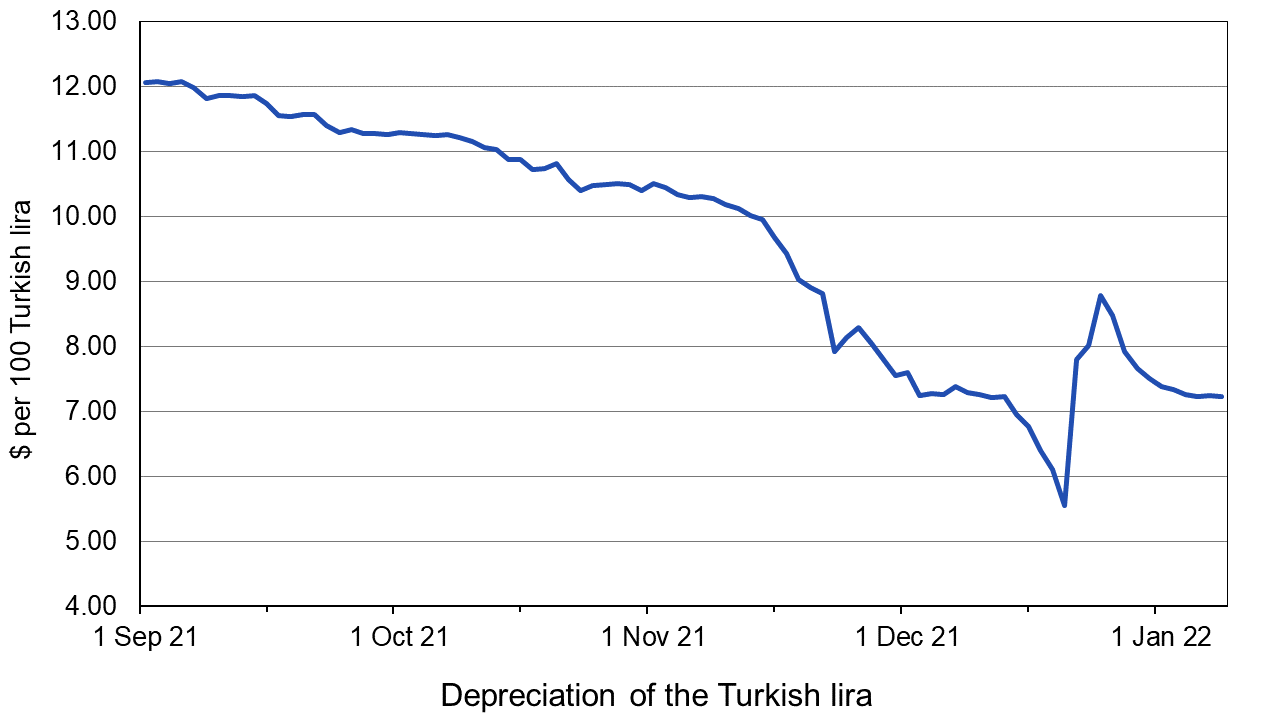
The cut in interest rates and rise in nominal aggregate demand led to a large depreciation in the exchange rate. On 1 September 2021, 100 Turkish lira exchanged for $12.05. By 11 January 2022 the rate had fallen to $7.22 – a 40.1% depreciation. This depreciation, in turn, further stoked inflation as the lower exchange rate pushed up the price of imported goods. (Click here for a PowerPoint of the chart.)
Attempts were made to stem this fall in the lira on 20 December, by which point 100 lira were trading for just $5.50 (see chart) and speculation against the lira was gathering momentum. President Erdoğan announced a scheme to protect lira deposits against currency volatility, guaranteeing lira deposits in hard currency terms. The mechanism adopted was a rise in the interest rate on lira deposits with a maturity of 3 to 12 months, thereby encouraging people to lock in deposits for the medium term and not, therefore, to use them to speculate against the lira by buying other currencies. Other interest rates would be unaffected. At the same time the central bank used foreign currency reserves to engage in large-scale purchases of the lira on the foreign exchange market.
The lira rallied. By 23 December, 100 lira were trading for $8.79. But then selling of the lira began again and, as stated above, by early January 100 lira had fallen to $7.22. The underlying problem of excess demand and high inflationary expectations had not been solved.
It remains to be seen whether the President will change his mind and decide that the central bank needs to raise interest rates to reduce inflation and restore confidence.
Videos
Articles
- Turkish Inflation Hits Highest Since 2002 Amid Lira Woes
Bloomberg, Baris Balci and Cagan Koc (3/1/22)
- Turkey’s annual inflation rate is over 82 percent, finds research group
Bianet (3/1/22)
- How Turkey can overcome its economic challenges
Arab News, Zaid M Belbagi (2/1/22)
- Turkey cuts interest rates despite spiralling inflation
BBC News, Victoria Craig (16/12/21)
- Turkey inflation surges 36% amid lira crisis, highest since 2002
CNBC (3/1/22)
- Turkey mulls new financial instruments to shield against inflation
Daily Sabah (3/1/22)
- Turkey raises minimum wage as lira crash, inflation sow hardship
Aljazeera, Umar Farooq (16/12/21)
- What to make of Turkey’s latest unorthodox currency move
Financial Times, Mohamed El-Erian (21/12/21)
- Erdoğan gambles on economy amid protests and rocketing inflation
The Guardian, Phillip Inman (24/11/21)
- Explained: How did Turkey’s economy go so wrong?
The Indian Express, Patricia Cohen (15/12/21)
Data
Questions
- Until the pandemic, the Turkish economy could be seen as a success story. Why?
- What supply-side policies did Turkey pursue?
- Use either an aggregate demand and supply diagram or a dynamic aggregate demand and supply (DAD/DAS) diagram to explain what has happened to inflation in Turkey in the past few months.
- Explain the thinking behind the successive cuts in interest rates since September 2021.
- Why did the measures introduced on 20 December 2021 only temporarily halt the depreciation of the lira?
- Choose a country with a higher rate of inflation than Turkey (see second data link above). Find out the causes of its high rate. Are they similar to those in Turkey?
 During the pandemic, millions of people’s wages in the UK were paid by the government to prevent the closure of businesses and a surge in unemployment. The furlough scheme officially came to an end in September 2021. However, with the spread of the Omicron variant and the fear of further restrictions being put in place, there has been a call by many to re-introduce the furlough scheme.
During the pandemic, millions of people’s wages in the UK were paid by the government to prevent the closure of businesses and a surge in unemployment. The furlough scheme officially came to an end in September 2021. However, with the spread of the Omicron variant and the fear of further restrictions being put in place, there has been a call by many to re-introduce the furlough scheme.
The furlough scheme
The furlough scheme began when the government brought in, what was officially called the Coronavirus Job Retention Scheme (CJRS) in early 2020. This was when the pandemic first forced businesses across the country to close. The scheme worked by paying part of employees’ wages, preventing the need for businesses to make their staff redundant, therefore avoiding a rapid rise in unemployment along with the associated costs. It also avoided the financial and emotional costs of firing and then rehiring workers post pandemic. Under the scheme, furloughed workers received 80% of their wages, up to £2500 a month, if they couldn’t work because of the impact of coronavirus. Employees were able to maintain the security of employment and the payments helped furloughed workers pay their bills.
 The scheme saw billions of pounds spent paying the wages of employees whose firms were forced to close temporarily. It could be argued that the expense of the scheme was a huge disadvantage. However, the alternative would have been for the government to pay unemployment-related benefits. Despite the furlough scheme being deemed necessary, it was not without its drawbacks for the structure of businesses. Rather than businesses adapting to changes in the economy and consumer demands, they could decide to claim the money and avoid the need to restructure. There was also concern about the length of the furlough scheme and the ability of businesses to bounce back post-pandemic.
The scheme saw billions of pounds spent paying the wages of employees whose firms were forced to close temporarily. It could be argued that the expense of the scheme was a huge disadvantage. However, the alternative would have been for the government to pay unemployment-related benefits. Despite the furlough scheme being deemed necessary, it was not without its drawbacks for the structure of businesses. Rather than businesses adapting to changes in the economy and consumer demands, they could decide to claim the money and avoid the need to restructure. There was also concern about the length of the furlough scheme and the ability of businesses to bounce back post-pandemic.
Since the start of the scheme, the specifics of what was paid and who received it changed over time, especially once the economy started opening again. Initial steps were made to allow part-time return to work and the scheme started to wind down over the summer of 2021, with the government covering less of the wages and businesses covering more. From July, employers had to provide 10% of the wages of their furloughed staff, with the government paying the rest. This then increased to 20% in August with the CJRS coming to a complete end on 30 September 2021. At this point, there were around 1.6 million employees still receiving payment from the scheme.
Impact on Employment
With the end to the furlough scheme in September 2021, there were concerns that this would lead to a large number of redundancies. However, data indicate that has not happened and there is a record number of job vacancies. Official figures show that UK employment rose in October, confirming the strength of the labour market. The Office for National Statistics stated that the employment rate rose to 75.5% in the three months to October, up 0.2 percentage points on the previous quarter. This is believed to be driven by a rise in part-time work, which had dropped sharply during the pandemic. However, it is important to note that the strength in these numbers was prior to the emergence of the Omicron variant.
Omicron
 In November, the government had ruled out once again bankrolling people’s wages at enormous expense. However, the Chancellor is now under pressure to respond to the latest announcements around the ever-changing landscape of the pandemic. The fast-spreading mutation of the Covid-19 virus, Omicron, is posing a fresh threat to the economy.
In November, the government had ruled out once again bankrolling people’s wages at enormous expense. However, the Chancellor is now under pressure to respond to the latest announcements around the ever-changing landscape of the pandemic. The fast-spreading mutation of the Covid-19 virus, Omicron, is posing a fresh threat to the economy.
On the 8 December, the Prime Minister announced new ‘Plan B’ Covid rules for England. As part of these new rules to limit the spread of Omicron, people are being asked to work from home again if possible and face masks are compulsory in most public places. Covid passes or a negative Covid test result are also needed to get into nightclubs and large venues.
Scotland and Wales have brought in further restrictions. Scotland’s First Minister, Nicola Sturgeon, has asked people to limit socialising to three households at a time in the run-up to Christmas. Shops and hospitality venues in Scotland must bring back physical distancing and screens. In Wales, nightclubs will close after 26 December and social distancing will be reintroduced in shops.
 Although the hospitality industry and retail sector remain open, they are facing a slump in trade thanks to the new restrictions and worries among the general public. With the work-from-home guidance and advice from health officials that people should limit their social interactions, pubs and restaurants have seen widespread cancellations in the run-up to Christmas. Trade is suffering and these mass cancellations come at a time when these sectors were hoping for bumper trade after a dismal last couple of years.
Although the hospitality industry and retail sector remain open, they are facing a slump in trade thanks to the new restrictions and worries among the general public. With the work-from-home guidance and advice from health officials that people should limit their social interactions, pubs and restaurants have seen widespread cancellations in the run-up to Christmas. Trade is suffering and these mass cancellations come at a time when these sectors were hoping for bumper trade after a dismal last couple of years.
In light of these concerns, ministers are now being urged to guarantee support in case businesses have to shut. Despite the indication that it would be highly unlikely that the UK would experience a full return to the restrictions seen at previous stages of the crisis, the International Monetary Fund has stated that the UK government should be drawing up contingency plans. The IMF has called for a mini-furlough scheme in the event that the Omicron variant forces the government to close parts of the economy. The idea is that the mini-furlough scheme would see a limited version of the multi-billion-pound job subsidy scheme being rolled out if firms are forced to close.
There are strong calls for there to be targeted support, which this mini-furlough scheme could offer. The Resolution Foundation argued in mid-December that a furlough scheme tied solely to the hospitality industry would help prevent job loses in an industry that is currently suffering once again. It calculated that the cost of a hospitality-only furlough scheme would be £1.4 billion a month if it were pitched at the original level of 80% of wage support. If a January to March sector-specific scheme were to be introduced it is estimated to cost around £5 billion, a small cost in comparison to £46 billion spent on furlough so far.
Inflation
Any reintroduction of a furlough scheme would be a jolt for the government. This would mean a return to the 2020-style arguments around protecting livelihoods and businesses, a contrast to the recent messaging from the Treasury of restoring public finances. There is also concern about how this will all impact on current growth predictions and inflation concerns. The IMF expects the growth of the UK economy to be 6.8% in 2021 and 5% in 2022. However, the drawback from this is that the recovery would also be accompanied by rising inflation. It has been suggested, therefore, that interest rate increases from the Bank of England would be needed to keep inflation under control, while at the same time being not so great as to kill off growth.
It was widely expected that the Bank of England would again put off a rate hike in order to wait to see the economic impact of Plan B restrictions. However, on Thursday 16 December, interest rates were raised for the first time in more than three years. Despite the fears that Omicron could slow the economy by causing people to spend less, Bank Rate was raised from 0.1% to 0.25% . This came in the wake of data showing prices climbing at the fastest pace for 10 years.
Next Steps?
Government finances would take another huge hit if the furlough scheme were revived. But a version of such a scheme is likely to be necessary to avert an unemployment crisis and the attendant costs.
However, in resisting further measures, the government has argued that it has already acted early to help control the virus’s spread by rapidly rolling out booster jabs, while avoiding unduly damaging economic and social restrictions.
The government also argues that some of the measures from the total £400 billion Covid support package since the start of the pandemic will continue to help businesses into Spring 2022. Such measures include government-backed loans for small- and medium-sized businesses until June 2022, a reduction in VAT from 20% to 12.5% until March 2022 and business rates relief for eligible retail, hospitality, and leisure businesses until March 2022. Talks are ongoing with hospitality and and other business organisations directly affected by Covid restrictions.
The British Chambers of Commerce has argued that current measures are not enough and has called for VAT on hospitality and tourism to be cut back to its emergency rate of 5% and for the 100% business rates relief for retailers to return. The CBI has also called for any unspent local authority grants to be spent now to help affected firms and that further help, including business rates relief, should be on the table if restrictions continue after the government’s 5 January review date. The IMF said that with strong policy support, the economy had proved resilient, but it stressed that a return of some of the measures that prevented mass unemployment and large-scale business failures might soon be needed.
Conclusion
Infections caused by the new Omicron variant are rising rapidly, doubling every two to three days. It is expected to become the dominant variant in the UK soon with health officials warning it may be the most significant threat since the start of the pandemic. However, it is not yet known what the full extent of the impact of this new variant on the NHS will be, leaving the severity of future restrictions uncertain.
But what is evident is that the course of the pandemic has changed and there is a growing case for the government to start planning for new support packages. Although a reintroduction of the furlough scheme was hoped not to be needed on the path out of the pandemic, a short detour may be required in the form of a mini-furlough scheme. The size and reach of any support put in place will depend upon any further restrictions on economic activity.
Articles
Questions
- Should the level of support for business return to the levels in place earlier in 2021?
- What measures could a government put in place to curtail the spread of the Omicron variant that have only a minimal impact on business and employment?
- Compare the UK measures to curtail the spread of the virus with those used in some other European countries.
- What are the arguments for and against (a) re-introducing the furlough scheme as it was earlier in 2021; (b) introducing a version restricted to the hospitality sector?
 To make a sensible comparison of one year’s national income generated from the production of goods and services with another we need to take inflation into account. Changes in inflation-adjusted GDP represent changes in the volume of production of a country’s goods and services: in other words, the real value of goods and services. We revisit the blog written back in April 2019, prior the pandemic, to show how changes in real GDP evidence what we may refer to as the twin characteristics of economic growth: positive long-term growth but with fluctuating short-term rates of growth.
To make a sensible comparison of one year’s national income generated from the production of goods and services with another we need to take inflation into account. Changes in inflation-adjusted GDP represent changes in the volume of production of a country’s goods and services: in other words, the real value of goods and services. We revisit the blog written back in April 2019, prior the pandemic, to show how changes in real GDP evidence what we may refer to as the twin characteristics of economic growth: positive long-term growth but with fluctuating short-term rates of growth.
Real and nominal GDP
The nominal or current-price estimate for UK Gross Domestic Product in 2020 is £2.156 trillion. It is the value of output produced within the country in 2020. This was a fall of 4.4 per cent on the £2.255 trillion recorded in 2019. These values make no adjustment for inflation and therefore reflect the prices of output that were prevailing at the time.
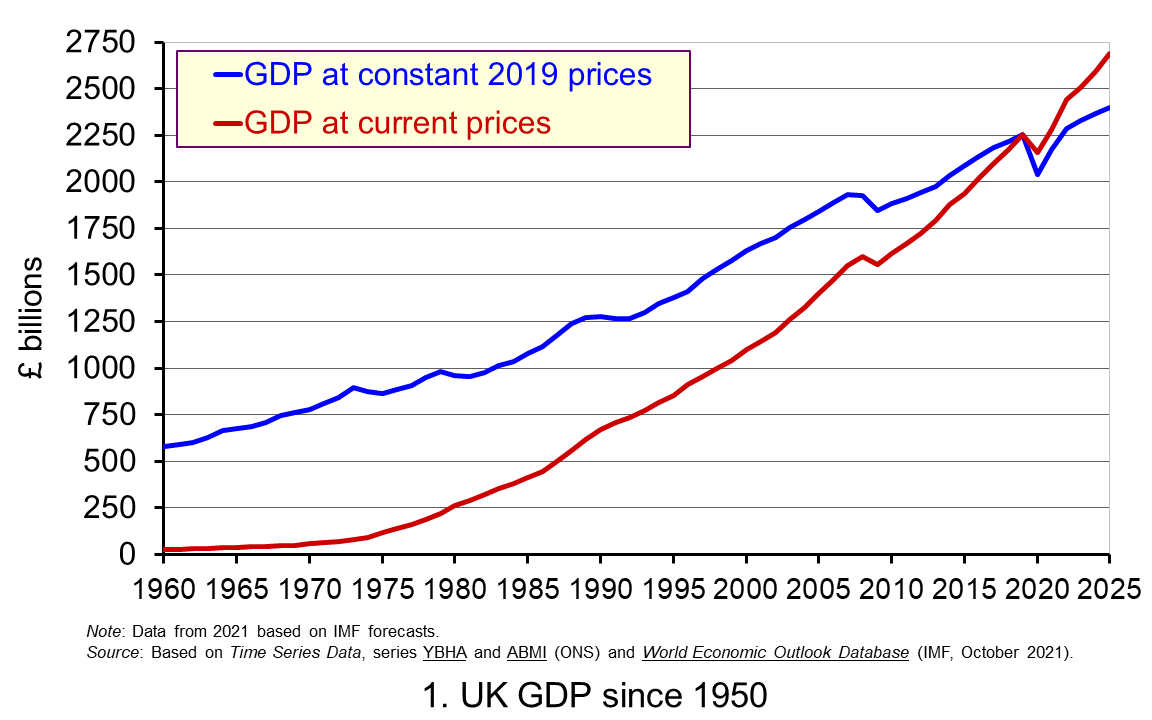 Chart 1 shows current-price estimates of GDP from 1950 when the value of GDP was estimated at £12.7 billion. The increase to £2.156 trillion in 2020 amounts to a proportionate increase of almost 170 times, a figure that rises to 211 times if we compare the 1950 value with the latest IMF estimate for 2025 of £2.689 trillion. However, if we want to make a more meaningful comparison of the country’s national income by looking at the longer-term increase in the volume of production, we need to adjust for inflation. (Click here to download a PowerPoint copy of the chart.)
Chart 1 shows current-price estimates of GDP from 1950 when the value of GDP was estimated at £12.7 billion. The increase to £2.156 trillion in 2020 amounts to a proportionate increase of almost 170 times, a figure that rises to 211 times if we compare the 1950 value with the latest IMF estimate for 2025 of £2.689 trillion. However, if we want to make a more meaningful comparison of the country’s national income by looking at the longer-term increase in the volume of production, we need to adjust for inflation. (Click here to download a PowerPoint copy of the chart.)
Long-term growth in real GDP
If we measure GDP at constant prices, we eliminate the effect of inflation. To construct a constant-price series for GDP a process known as chain-linking is used. This involves taking consecutive pairs of years, e.g. 2020 and 2021, and estimating what GDP would be in the most recent year (in this case, 2021) if the previous year’s prices (i.e. 2020) had continued to prevail. By calculating the percentage change from the previous year’s GDP value we have an estimate of the volume change. If this is repeated for other pairs of years, we have a series of percentage changes that capture the volume changes from year-to-year. Finally, a reference year is chosen and the percentage changes are applied backwards and forwards from the nominal GDP value for the reference year – the volume changes forwards and backwards from this point.
In effect, a real GDP series creates a quantity measure in monetary terms. Chart 1 shows GDP at constant 2019 prices (real GDP) alongside GDP at current prices (nominal GDP). Consider first the real GDP numbers for 1950 and 2020. GDP in 1950 at 2019 prices was £410.1 billion. This is higher than the current-price value because prices in 2019 (the reference year) were higher than those in 1950. Meanwhile, GDP in 2020 when measured at 2019 prices was £2.037 trillion. This constant-price value is smaller than the corresponding current-price value because prices in 2019 where lower than those in 2020.
Between 1950 and 2020 real GDP increased 5.0 times. If we extend the period to 2025, again using the latest IMF estimates, the increase is 5.9 times. Because we have removed the effect of inflation, the real growth figure is much lower than the nominal growth figure. Crucially, what we are left with is an indicator of the long-term growth in the volume of the economy’s output and hence an increase in national income that is backed up by an increase in production. Whereas nominal growth rates are affected both by changes in volumes and prices, real growth rates reflect only changes in volumes.
The upward trajectory observed in constant-price GDP is therefore evidence of positive longer-term growth. This is one of the twin characteristics of growth.
Short-term fluctuations in the growth of real GDP
The second characteristic is fluctuations in the rate of growth from period to period. We can see this second characteristic more clearly by plotting the percentage change in real GDP from year to year.
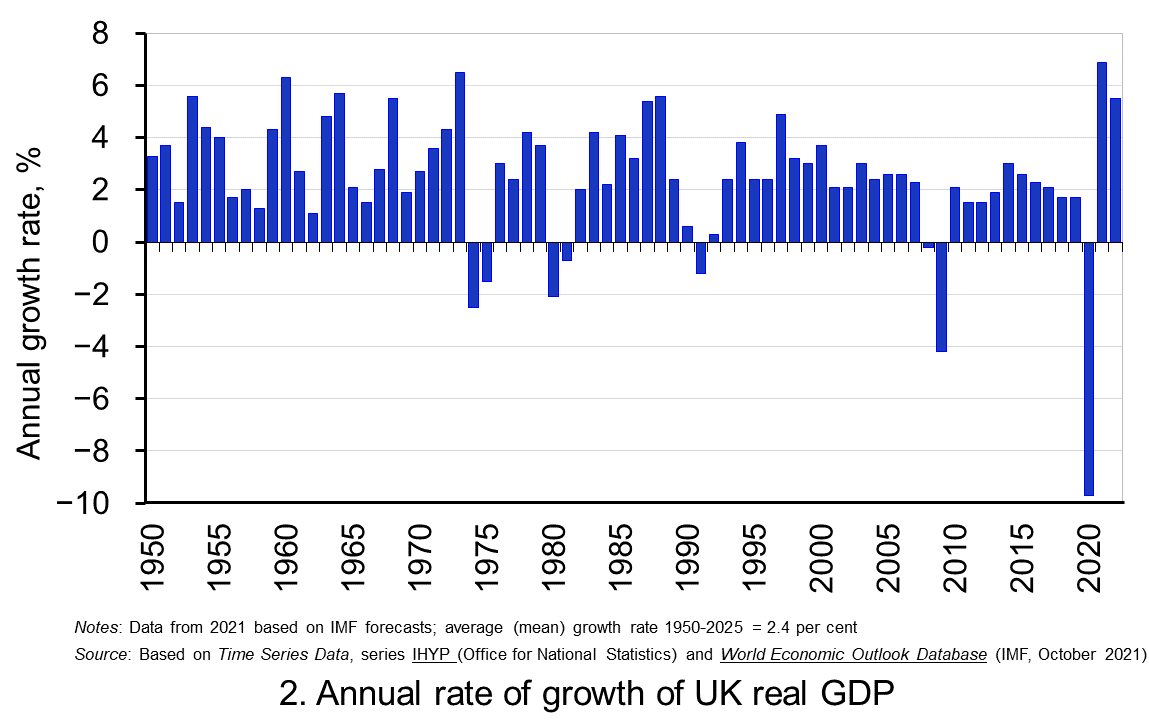 Chart 2 shows the annual rate of growth in real GDP each year since 1950. From it, we see the inherent instability that is a key characteristic of the macroeconomic environment. This instability is, of course, mirrored in the output path of real GDP in Chart 1, but the annual rates of growth show the instability more clearly. We can readily see the impact on national output of the global financial crisis and the global health emergency.
Chart 2 shows the annual rate of growth in real GDP each year since 1950. From it, we see the inherent instability that is a key characteristic of the macroeconomic environment. This instability is, of course, mirrored in the output path of real GDP in Chart 1, but the annual rates of growth show the instability more clearly. We can readily see the impact on national output of the global financial crisis and the global health emergency.
In 2009, constant-price GDP in the UK fell by 4.25 per cent. Then, in 2020, constant-price GDP and, hence, the volume of national output fell by 9.7 per cent, as compared to a 4.4 per cent fall in current-price GDP that we identified earlier. These global, ‘once-in-a-generation’ shocks are stark examples of the instability that characterises economies and which generate the ‘ups and downs’ in an economy’s output path, known more simply as ‘the business cycle’. (Click here to download a PowerPoint copy of the chart.)
Determinants of long-and short-term growth
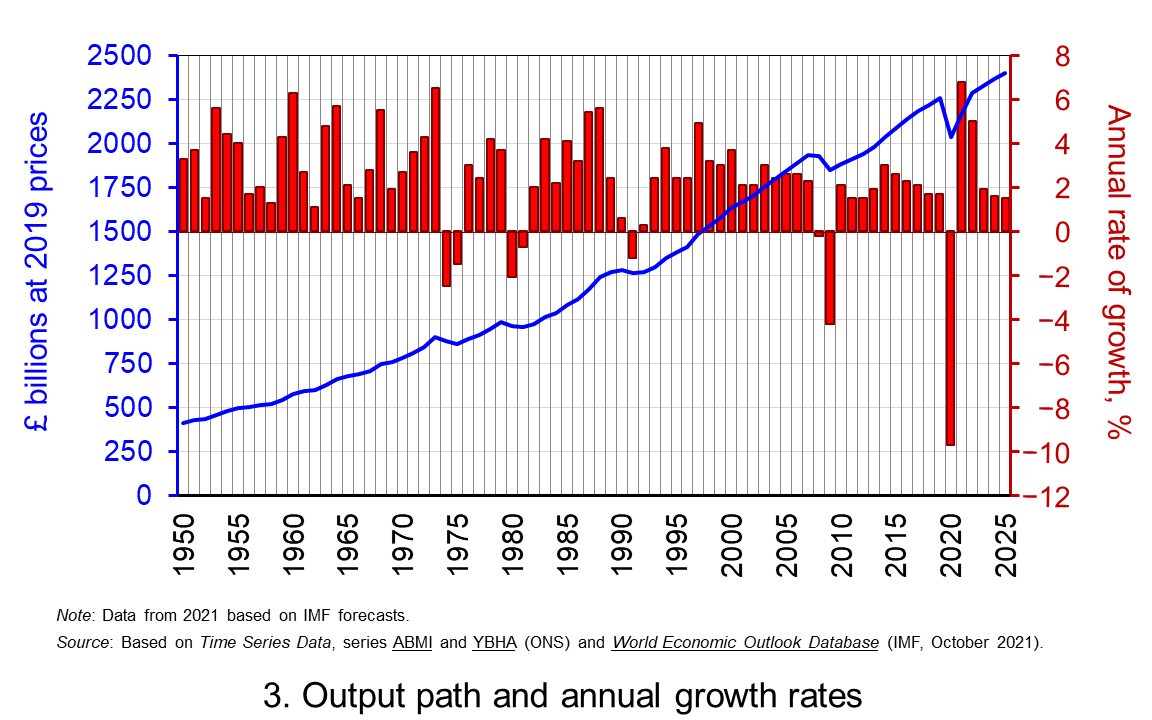 The twin characteristics of growth can be seen simultaneously by combining the output path captured by the levels of real GDP with the annual rates of growth. This is shown in Chart 3. The longer-term growth seen in the economy’s output path is generally argued to be driven by the quantity and quality of the economy’s resources, and their effectiveness when combined in production. In other words, it is the supply-side that determines the trajectory of the output path over the longer term. (Click here to download a PowerPoint copy of the chart.)
The twin characteristics of growth can be seen simultaneously by combining the output path captured by the levels of real GDP with the annual rates of growth. This is shown in Chart 3. The longer-term growth seen in the economy’s output path is generally argued to be driven by the quantity and quality of the economy’s resources, and their effectiveness when combined in production. In other words, it is the supply-side that determines the trajectory of the output path over the longer term. (Click here to download a PowerPoint copy of the chart.)
However, the fluctuations we observe in short-term growth rates tend to reflect impulses that affect the ability and or willingness of producers to supply (supply-side shocks) and purchasers to consume (demand-side shocks). These impulses are then propagated and their effects, therefore, transmitted through the economy.
Effects of the pandemic
The pandemic is unusual in that the health intervention measures employed by governments around the world resulted in simultaneous negative aggregate demand and aggregate supply shocks. Economists were particularly concerned that the magnitude of these impulses and their propagation had the potential to generate scarring effects and hence negative hysteresis effects. The concern was that these would affect the level of real GDP in the medium-to-longer term and, hence, the vertical position of the output path, as well as the longer-term rate of growth and, hence, the steepness of the output path.
The extent of these scarring effects continues to be debated. The ability of businesses and workers to adapt their practices, the extraordinary fiscal and monetary measures that were undertaken in many countries, and the roll-out of vaccines programmes, especially in advanced economies, have helped to mitigate some of these effects. For example, the latest IMF forecasts for output in the USA in 2024 are over 2 per cent higher than those made back in October 2019.
Scarring effects are, however, thought to be an ongoing issue in the UK. The IMF is now expecting output in the UK to be nearly 3 per cent lower than it originally forecast back in October 2019. Therefore, whilst UK output is set to recover, scarring effects on the UK economy will mean that the output path traced out by real GDP will remain, at least in the medium term, vertically lower than was expected before the pandemic.
Data and Reports
Articles
Questions
- What do you understand by the term ‘macroeconomic environment’? What data could be used to describe the macroeconomic environment?
- When a country experiences positive rates of inflation, which is higher: nominal economic growth or real economic growth?
- Does an increase in nominal GDP mean a country’s production has increased? Explain your answer.
- Does a decrease in nominal GDP mean a country’s production has decreased? Explain your answer.
- Why does a change in the growth of real GDP allow us to focus on what has happened to the volume of production?
- What does the concept of the ‘business cycle’ have to do with real rates of economic growth?
- When would falls in real GDP be classified as a recession?
- Distinguish between the concepts of ‘short-term growth rates’ and ‘longer-term growth’.
- What do you understand by the term hysteresis? By what means can hysteresis effects be generated?
- Discuss the proposition that the pandemic could have a positive effect on longer-term growth rates because of the ways that people and business have had to adapt.
 The global battle for fuel is expected to peak this winter. The combination of rising demand and a tightening of supply has sparked concerns of shortages in the market. Some people are worried about another ‘winter of discontent’. Gas prices have risen fivefold in Europe as a whole.
The global battle for fuel is expected to peak this winter. The combination of rising demand and a tightening of supply has sparked concerns of shortages in the market. Some people are worried about another ‘winter of discontent’. Gas prices have risen fivefold in Europe as a whole.
In the UK, consumers are likely to find that the natural gas needed to heat their homes this October will cost at least five times more than it did a year ago. This surge in wholesale gas prices has seen several UK energy suppliers stop trading as they are unable to make a profit. This is because of an energy price cap for some consumers and various fixed price deals they had signed with their customers.
There are thus fears of an energy crisis in the UK, especially if there is a cold winter. There are even warnings that during a cold snap, gas supply to various energy-intensive firms may be cut off. This comes at a time when some of these industries are struggling to make a profit.
Demand and supply
The current situation is a combination of long- and short-term factors. In spring 2020, the demand for gas actually decreased due to the pandemic. This resulted in low gas prices, reduced UK production and delayed maintenance work and investment along global supply chains. However, since early 2021, consumer demand for gas has soared. First, there was an increased demand due to the Artic weather conditions last winter. This was then followed by heatwaves in the USA and Europe over the summer, which saw an increase in the use of air conditioning units. With the increased demand combined with calm weather conditions, wind turbines couldn’t supply enough power to meet demand.
 There has also been a longer-term impact on demand throughout the industry due to the move to cleaner energy. The transitioning to wind and solar has seen a medium-term increase in the demand for gas. There is also a long-term impact of the target for net zero economies in the UK and Europe. This has hindered investors’ willingness to invest in developing supplies of fossil fuels due the fact they could become obsolete over the next few decades.
There has also been a longer-term impact on demand throughout the industry due to the move to cleaner energy. The transitioning to wind and solar has seen a medium-term increase in the demand for gas. There is also a long-term impact of the target for net zero economies in the UK and Europe. This has hindered investors’ willingness to invest in developing supplies of fossil fuels due the fact they could become obsolete over the next few decades.
Nations have also been unable to build up enough supplies for winter. This is partly due to Europe’s domestic gas stocks having declined by 30% per cent in the past decade. This heightened situation is leading to concerns that there will be black-outs or cut-offs in gas this winter.
Importation of gas
 A concern for the UK is that it has scant storage facilities with no long-term storage. The UK currently has very modest amounts of storage – less than 6% of annual demand and some five times less than the average in the rest of Europe. It has been increasingly operating a ‘just-in-time model’, which is more affected by short-term price fluctuations in the wholesale gas market. With wind power generation remaining lower than average during summer 2021, more gas than usual has been used to generate electricity, leaving less gas to go into storage.
A concern for the UK is that it has scant storage facilities with no long-term storage. The UK currently has very modest amounts of storage – less than 6% of annual demand and some five times less than the average in the rest of Europe. It has been increasingly operating a ‘just-in-time model’, which is more affected by short-term price fluctuations in the wholesale gas market. With wind power generation remaining lower than average during summer 2021, more gas than usual has been used to generate electricity, leaving less gas to go into storage.
However, some argue that the problem is not just the UK’s physical supply of gas but demand for gas from elsewhere. Around half of the UK’s supply comes from its own production sites, while the rest is piped in from Europe or shipped in as liquefied natural gas (LNG) from the USA, Qatar and Russia. In 2019, the UK imported almost 20% of its gas through LNG shipments. However, Asian gas demand has grown rapidly, expanding by 50% over the past decade. This has meant that LNG has now become much harder to secure.
The issue is the price the UK has to pay to continue receiving these supplies. Some in the gas industry believe the price surge is only temporary, caused by economic disruptions, while many others say it highlights a structural weakness in a continent that has become too reliant on imported gas. It can be argued that the gas crisis has highlighted the lack of a coherent strategy to manage the gas industry as the UK transitions to a net zero economy. The lack of any industry investment in new capacity suggests that there is currently no business case for new long-term storage in the UK, especially as gas demand is expected to continue falling over the longer term.
Impact on consumers and industry
 Gas prices for suppliers have increased fivefold over the past year. Therefore, many companies face a considerable rise in their bills. MSome may need to reduce or pause production – or even cease trading – which could cause job losses. Alternatively, they could pass on their increased costs to customers by charging them higher prices. Although energy-intensive industries are particularly exposed, every company that has to pay energy bills will be affected. Due to the growing concerns about the security of winter gas supplies those industries reliant on gas, such as the fertiliser industry, are restricting production, threatening various supply chains.
Gas prices for suppliers have increased fivefold over the past year. Therefore, many companies face a considerable rise in their bills. MSome may need to reduce or pause production – or even cease trading – which could cause job losses. Alternatively, they could pass on their increased costs to customers by charging them higher prices. Although energy-intensive industries are particularly exposed, every company that has to pay energy bills will be affected. Due to the growing concerns about the security of winter gas supplies those industries reliant on gas, such as the fertiliser industry, are restricting production, threatening various supply chains.
Most big domestic gas suppliers buy their gas months in advance, meaning they will most likely pass on the higher price rises they have experienced in the past few months. The increased demand and decreased supply has already meant meant that customers have faced higher prices for their energy. The UK has been badly hit because it’s one of Europe’s biggest users of natural gas – 85% of homes use gas central heating – and it also generates a third of the country’s electricity.
The rising bills are particularly an issue for those customers on a variable tariff. About 15 million households have seen their energy bills rise by 12% since the beginning of October due to the rise in the government’s energy price cap calculated by the regulator, Ofgem. A major concern is that this increase in bills comes at a time when the need to use more heating and lighting is approaching. It also coincides with other price rises hitting family budgets and the withdrawal of COVID support schemes.
Government intervention – maximum pricing
If the government feels that the equilibrium price in a particular market is too high, it can intervene in the market and set a maximum price. When the government intervenes in this way, it sets a price ceiling on certain basic goods or services and does not permit the price to go above that set limit. A maximum price is normally set for reasons of fairness and to benefit consumers on low incomes. Examples include energy price caps to order to control fuel bills, rent controls in order to improve affordability of housing, a cap on mobile roaming charges within the EU and price capping for regional monopoly water companies.
The energy price cap
 Even without the prospect of a colder than normal winter, bills are still increasing. October’s increase in the fuel cap means that many annual household fuel bills will rise by £135 or more. The price cap sets the maximum price that suppliers in England, Wales and Scotland can charge domestic customers on a standard, or default tariff. The cap has come under the spotlight owing to the crisis among suppliers, which has seen eleven firms fold, with more expected.
Even without the prospect of a colder than normal winter, bills are still increasing. October’s increase in the fuel cap means that many annual household fuel bills will rise by £135 or more. The price cap sets the maximum price that suppliers in England, Wales and Scotland can charge domestic customers on a standard, or default tariff. The cap has come under the spotlight owing to the crisis among suppliers, which has seen eleven firms fold, with more expected.
The regulator Ofgem sets a price cap for domestic energy twice a year. The latest level came into place on 1 October. It is a cap on the price of energy that suppliers can charge. The price cap is based on a broad estimate of how much it costs a supplier to provide gas and electricity services to a customer. The calculation is mainly made up of wholesale energy costs, network costs such as maintaining pipes and wires, policy costs including Government social and environmental schemes, operating costs such as billing and metering services and VAT. Therefore, suppliers can only pass on legitimate costs of supplying energy and cannot charge more than the level of the price cap, although they can charge less. A household’s total bill is still determined by how much gas and electricity is used.
- Those on standard tariffs, with typical household levels of energy use, will see an increase of £139.
- People with prepayment meters, with average energy use, will see an annual increase of £153.
- Households on fixed tariffs will be unaffected. However, those coming to the end of a contract are automatically moved to a default tariff set at the new level.
Ordinarily, customers are able to shop around for cheaper deals, but currently, the high wholesale prices of gas means that cheaper deals are not available.
Despite the cap limiting how much providers can raise prices, the current increase is the biggest (and to the highest amount) since the cap was introduced in January 2019. As providers are scarcely making a profit on gas, there are concerns that a further increase in wholesale prices will cause more suppliers to be forced out of business. Ofgem said that the cap is likely to go up again in April, the next time it is reviewed.
Conclusion
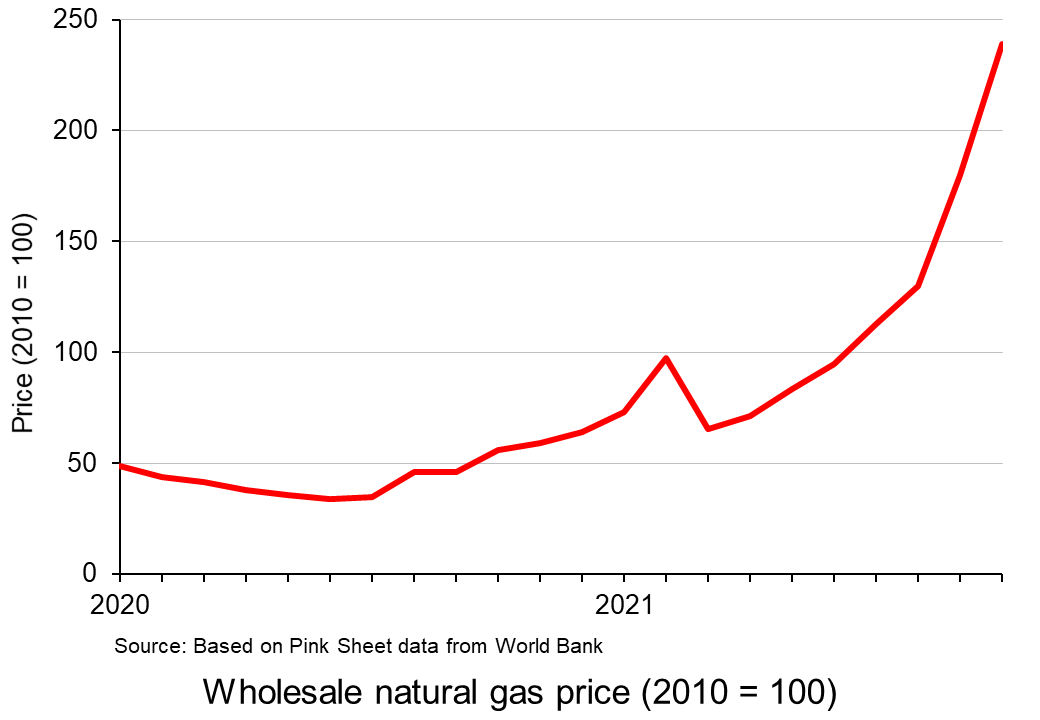 The record prices being paid by suppliers and deficits in gas supply across the world have stoked fears that the energy crisis will get worse. It comes at a time when households are already facing rising bills, while some energy-intensive industries have started to slow production. This has started to dent optimism around the post-pandemic economic recovery.
The record prices being paid by suppliers and deficits in gas supply across the world have stoked fears that the energy crisis will get worse. It comes at a time when households are already facing rising bills, while some energy-intensive industries have started to slow production. This has started to dent optimism around the post-pandemic economic recovery.
Historically, UK governments have trusted market mechanisms to deliver UK gas security. However, consumers are having to pay the cost of such an approach. The price cap has meant the UK’s gas bills have until now been typically lower than the EU average. However, the rise in prices comes on top of other economic problems such as labour shortages and increasing food prices, adding up to an unwelcome rise in the cost of living.
Video
Articles
UK government/Ofgem
Questions
- Using a supply and demand diagram, illustrate what has happened in the energy market over the past year.
- What are the advantages and disadvantages of government intervention in a free market?
- Explain why it is necessary for the regulator to intervene in the energy market.
- Using the concept of maximum pricing, illustrate how the price cap works.
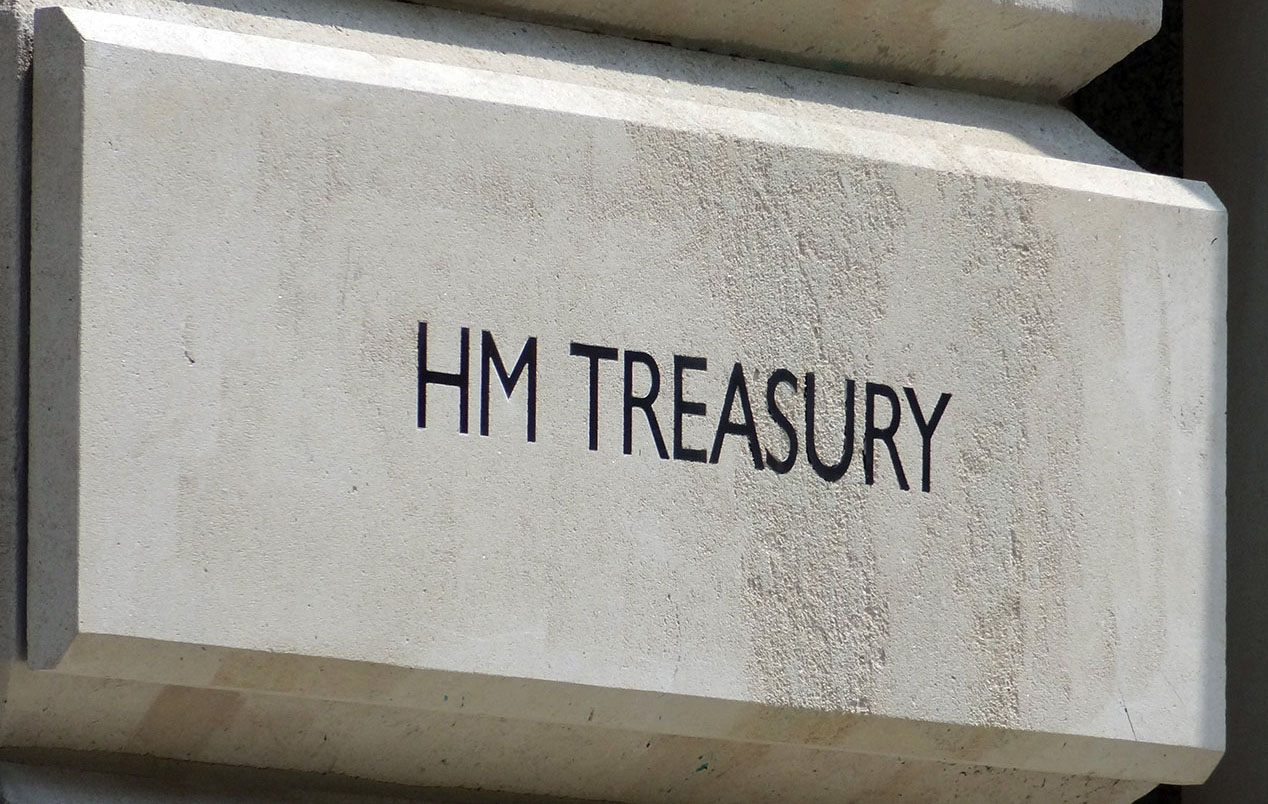 The COVID-19 pandemic had a stark effect on countries’ public finances. Governments had to make difficult fiscal choices around spending and taxation to safeguard public health, and the protection of jobs and incomes both in the present and in the future. The fiscal choices were to have historically large effects on the size of public spending and on the size of public borrowing.
The COVID-19 pandemic had a stark effect on countries’ public finances. Governments had to make difficult fiscal choices around spending and taxation to safeguard public health, and the protection of jobs and incomes both in the present and in the future. The fiscal choices were to have historically large effects on the size of public spending and on the size of public borrowing.
Here we briefly summarise the magnitude of these effects on public spending, receipts and borrowing in the UK.
The public sector comprises both national government and local or regional government. In financial year 2019/20 public spending in the UK was £886 billion. This would rise to £1.045 trillion in 2020/21. To understand better the magnitude of these figures we can express them as a share of national income (Gross Domestic Product). In 2019/20 public spending was 39.8 per cent of national income. This rose to 52.1 per cent in 2020/21. Meanwhile, public-sector receipts, largely taxation, fell from £829.1 billion in 2019/20 to £796.5 billion in 2020/21, though, because of the fall in national income, the share of receipts in national income rose very slightly from 37.3 to 37.9 per cent of national income.
The chart shows both public spending and public receipts as a share of national income since 1900. (Click here for a PowerPoint of the chart.) What this chart shows is the extraordinary impact of the two World Wars on the relative size of public spending. We can also see an uptick in public spending following the global financial crisis and, of course, the COVID-19 pandemic. The chart also shows that spending is typically larger than receipts meaning that the public sector typically runs a budget deficit. 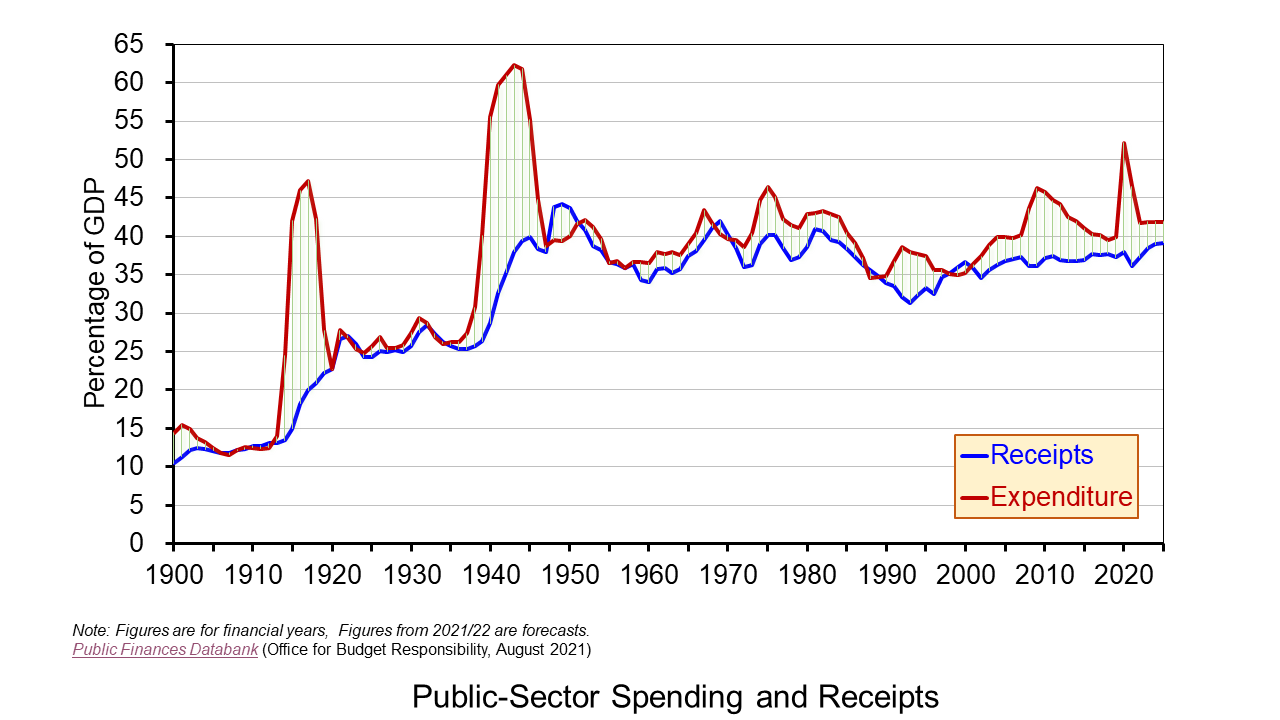 .
.
If we focus on public spending as a share of national income and its level following the two world wars, we can see that it did not fall back to pre-war levels. This is what Peacock and Wiseman (1961) famously referred to as a displacement effect. They attributed this to, among other things, an increase in the public’s tolerance to pay higher taxation because of the higher taxes levied during the war as well as to a desire for greater public intervention. The latter arose from an inspection effect. This can be thought of as a public consciousness effect, with the war helping to shine a light on a range of economic and social issues, such as health, housing and social security. These two effects, it is argued, reinforced each other, allowing the burden of taxation to rise and, hence, public spending to increase relative to national income.
If we forward to the global financial crisis, we can again see public spending rise as a share of national income. However, this time the ratio did not remain above pre-crisis levels. Rather, the UK government was fearful of unsustainable borrowing levels and the crowding out of private-sector activity by the public sector, with higher interest rates making public debt an attractive proposition for investors. It thus sought to reduce the public-sector deficit by engaging in what became known as ‘austerity’ measures.
 If we move forward further to the COVID-19 pandemic, we see an even more significant spike in public spending as a share of national income. It is of course rather early to make predictions about whether the pandemic will have enduring effects on public spending and taxation. Nonetheless the pandemic, in a similar way to the two world wars, has sparked public debates on many economic and social issues. Whilst debates around the funding of health and social care are longstanding, it could be argued that the pandemic has provided the government with the opportunity to introduce the 1.25 percentage point levy from April 2022 on the earned incomes of workers (both employees and the self-employed) and on employers. (See John’s blog Fair care? for a fuller discussion on the tax changes to pay for increased health and social care expenditure).
If we move forward further to the COVID-19 pandemic, we see an even more significant spike in public spending as a share of national income. It is of course rather early to make predictions about whether the pandemic will have enduring effects on public spending and taxation. Nonetheless the pandemic, in a similar way to the two world wars, has sparked public debates on many economic and social issues. Whilst debates around the funding of health and social care are longstanding, it could be argued that the pandemic has provided the government with the opportunity to introduce the 1.25 percentage point levy from April 2022 on the earned incomes of workers (both employees and the self-employed) and on employers. (See John’s blog Fair care? for a fuller discussion on the tax changes to pay for increased health and social care expenditure).
The extent to which there may be a pandemic displacement effect will depend on the fiscal choices made in the months and years ahead. The key question is how powerful will be the effect of social issues like income and wealth inequality, regional and inter-generational disparities, discrimination, poor infrastructure and educational opportunities in shaping these fiscal choices? Will these considerations carry more weight than the push to consolidate the public finances and tighten the public purse? These fiscal choices will determine the extent of any displacement effect in public spending and taxation.
Reference
Alan Peacock and Jack Wiseman, The Growth in Public Expenditure in the United Kingdom, Princeton University Press (1961).
Articles
Questions
- What do you understand by the term ‘public finances’?
- Why might you wish to express the size of public spending relative to national income rather than simply as an absolute amount?
- Undertake research to identify key pieces of social policy in the UK that were enacted at or around the times of the two World Wars.
- What do you understand by the terms ‘tolerable tax burden’ and ‘inspection effect’?
- Identify those social issues that you think have come into the spotlight as a result of the pandemic. Undertake research on any one of these and write a briefing note exploring the issue and the possible policy choices available to government.
- What is the concept of crowding out? How might it affect fiscal choices?
- How would you explain the distinction between public-sector borrowing and public-sector debt? Why could the former fall and the latter rise at the same time?
 Inflation has been rising around the world as a combination of a recovery in demand and supply-chain issues have resulted in aggregate demand exceeding aggregate supply. Annual consumer price inflation at the beginning of 2022 is around 2.5% in China, 3.5% in Sweden, 5% in the eurozone, Canada and India, 6% in the UK and South Africa, 7% in the USA and 7.5% in Mexico. In each case it is forecast to go a little higher before falling back again.
Inflation has been rising around the world as a combination of a recovery in demand and supply-chain issues have resulted in aggregate demand exceeding aggregate supply. Annual consumer price inflation at the beginning of 2022 is around 2.5% in China, 3.5% in Sweden, 5% in the eurozone, Canada and India, 6% in the UK and South Africa, 7% in the USA and 7.5% in Mexico. In each case it is forecast to go a little higher before falling back again. Why is Turkey’s inflation so much higher than in most developed and emerging economies and why has it risen so rapidly? The answer is that aggregate demand has been excessively boosted – well ahead of the ability of supply to respond. This has driven inflation expectations.
Why is Turkey’s inflation so much higher than in most developed and emerging economies and why has it risen so rapidly? The answer is that aggregate demand has been excessively boosted – well ahead of the ability of supply to respond. This has driven inflation expectations.
 How Bad Can Inflation Be? Turkey Offers a Warning
How Bad Can Inflation Be? Turkey Offers a Warning Turkey Inflation Surges to 19-Year High
Turkey Inflation Surges to 19-Year High Turkey: Soaring inflation puts Erdoğan under pressure
Turkey: Soaring inflation puts Erdoğan under pressure During the pandemic, millions of people’s wages in the UK were paid by the government to prevent the closure of businesses and a surge in unemployment. The furlough scheme officially came to an end in September 2021. However, with the spread of the Omicron variant and the fear of further restrictions being put in place, there has been a call by many to re-introduce the furlough scheme.
During the pandemic, millions of people’s wages in the UK were paid by the government to prevent the closure of businesses and a surge in unemployment. The furlough scheme officially came to an end in September 2021. However, with the spread of the Omicron variant and the fear of further restrictions being put in place, there has been a call by many to re-introduce the furlough scheme.  The scheme saw billions of pounds spent paying the wages of employees whose firms were forced to close temporarily. It could be argued that the expense of the scheme was a huge disadvantage. However, the alternative would have been for the government to pay unemployment-related benefits. Despite the furlough scheme being deemed necessary, it was not without its drawbacks for the structure of businesses. Rather than businesses adapting to changes in the economy and consumer demands, they could decide to claim the money and avoid the need to restructure. There was also concern about the length of the furlough scheme and the ability of businesses to bounce back post-pandemic.
The scheme saw billions of pounds spent paying the wages of employees whose firms were forced to close temporarily. It could be argued that the expense of the scheme was a huge disadvantage. However, the alternative would have been for the government to pay unemployment-related benefits. Despite the furlough scheme being deemed necessary, it was not without its drawbacks for the structure of businesses. Rather than businesses adapting to changes in the economy and consumer demands, they could decide to claim the money and avoid the need to restructure. There was also concern about the length of the furlough scheme and the ability of businesses to bounce back post-pandemic.  In November, the government had ruled out once again bankrolling people’s wages at enormous expense. However, the Chancellor is now under pressure to respond to the latest announcements around the ever-changing landscape of the pandemic. The fast-spreading mutation of the Covid-19 virus, Omicron, is posing a fresh threat to the economy.
In November, the government had ruled out once again bankrolling people’s wages at enormous expense. However, the Chancellor is now under pressure to respond to the latest announcements around the ever-changing landscape of the pandemic. The fast-spreading mutation of the Covid-19 virus, Omicron, is posing a fresh threat to the economy.  Although the hospitality industry and retail sector remain open, they are facing a slump in trade thanks to the new restrictions and worries among the general public. With the work-from-home guidance and advice from health officials that people should limit their social interactions, pubs and restaurants have seen widespread cancellations in the run-up to Christmas. Trade is suffering and these mass cancellations come at a time when these sectors were hoping for bumper trade after a dismal last couple of years.
Although the hospitality industry and retail sector remain open, they are facing a slump in trade thanks to the new restrictions and worries among the general public. With the work-from-home guidance and advice from health officials that people should limit their social interactions, pubs and restaurants have seen widespread cancellations in the run-up to Christmas. Trade is suffering and these mass cancellations come at a time when these sectors were hoping for bumper trade after a dismal last couple of years.  To make a sensible comparison of one year’s national income generated from the production of goods and services with another we need to take inflation into account. Changes in inflation-adjusted GDP represent changes in the volume of production of a country’s goods and services: in other words, the real value of goods and services. We revisit the
To make a sensible comparison of one year’s national income generated from the production of goods and services with another we need to take inflation into account. Changes in inflation-adjusted GDP represent changes in the volume of production of a country’s goods and services: in other words, the real value of goods and services. We revisit the  Chart 1 shows current-price estimates of GDP from 1950 when the value of GDP was estimated at £12.7 billion. The increase to £2.156 trillion in 2020 amounts to a proportionate increase of almost 170 times, a figure that rises to 211 times if we compare the 1950 value with the latest IMF estimate for 2025 of £2.689 trillion. However, if we want to make a more meaningful comparison of the country’s national income by looking at the longer-term increase in the volume of production, we need to adjust for inflation. (Click
Chart 1 shows current-price estimates of GDP from 1950 when the value of GDP was estimated at £12.7 billion. The increase to £2.156 trillion in 2020 amounts to a proportionate increase of almost 170 times, a figure that rises to 211 times if we compare the 1950 value with the latest IMF estimate for 2025 of £2.689 trillion. However, if we want to make a more meaningful comparison of the country’s national income by looking at the longer-term increase in the volume of production, we need to adjust for inflation. (Click  Chart 2 shows the annual rate of growth in real GDP each year since 1950. From it, we see the inherent instability that is a key characteristic of the macroeconomic environment. This instability is, of course, mirrored in the output path of real GDP in Chart 1, but the annual rates of growth show the instability more clearly. We can readily see the impact on national output of the global financial crisis and the global health emergency.
Chart 2 shows the annual rate of growth in real GDP each year since 1950. From it, we see the inherent instability that is a key characteristic of the macroeconomic environment. This instability is, of course, mirrored in the output path of real GDP in Chart 1, but the annual rates of growth show the instability more clearly. We can readily see the impact on national output of the global financial crisis and the global health emergency. The twin characteristics of growth can be seen simultaneously by combining the output path captured by the levels of real GDP with the annual rates of growth. This is shown in Chart 3. The longer-term growth seen in the economy’s output path is generally argued to be driven by the quantity and quality of the economy’s resources, and their effectiveness when combined in production. In other words, it is the supply-side that determines the trajectory of the output path over the longer term. (Click
The twin characteristics of growth can be seen simultaneously by combining the output path captured by the levels of real GDP with the annual rates of growth. This is shown in Chart 3. The longer-term growth seen in the economy’s output path is generally argued to be driven by the quantity and quality of the economy’s resources, and their effectiveness when combined in production. In other words, it is the supply-side that determines the trajectory of the output path over the longer term. (Click  The global battle for fuel is expected to peak this winter. The combination of rising demand and a tightening of supply has sparked concerns of shortages in the market. Some people are worried about another ‘winter of discontent’. Gas prices have risen fivefold in Europe as a whole.
The global battle for fuel is expected to peak this winter. The combination of rising demand and a tightening of supply has sparked concerns of shortages in the market. Some people are worried about another ‘winter of discontent’. Gas prices have risen fivefold in Europe as a whole.  There has also been a longer-term impact on demand throughout the industry due to the move to cleaner energy. The transitioning to wind and solar has seen a medium-term increase in the demand for gas. There is also a long-term impact of the target for net zero economies in the UK and Europe. This has hindered investors’ willingness to invest in developing supplies of fossil fuels due the fact they could become obsolete over the next few decades.
There has also been a longer-term impact on demand throughout the industry due to the move to cleaner energy. The transitioning to wind and solar has seen a medium-term increase in the demand for gas. There is also a long-term impact of the target for net zero economies in the UK and Europe. This has hindered investors’ willingness to invest in developing supplies of fossil fuels due the fact they could become obsolete over the next few decades.  A concern for the UK is that it has scant storage facilities with no long-term storage. The UK currently has very modest amounts of storage – less than 6% of annual demand and some five times less than the average in the rest of Europe. It has been increasingly operating a ‘
A concern for the UK is that it has scant storage facilities with no long-term storage. The UK currently has very modest amounts of storage – less than 6% of annual demand and some five times less than the average in the rest of Europe. It has been increasingly operating a ‘ Gas prices for suppliers have increased fivefold over the past year. Therefore, many companies face a considerable rise in their bills. MSome may need to reduce or pause production – or even cease trading – which could cause job losses. Alternatively, they could pass on their increased costs to customers by charging them higher prices. Although energy-intensive industries are particularly exposed, every company that has to pay energy bills will be affected. Due to the growing concerns about the security of winter gas supplies those industries reliant on gas, such as the fertiliser industry, are restricting production, threatening various supply chains.
Gas prices for suppliers have increased fivefold over the past year. Therefore, many companies face a considerable rise in their bills. MSome may need to reduce or pause production – or even cease trading – which could cause job losses. Alternatively, they could pass on their increased costs to customers by charging them higher prices. Although energy-intensive industries are particularly exposed, every company that has to pay energy bills will be affected. Due to the growing concerns about the security of winter gas supplies those industries reliant on gas, such as the fertiliser industry, are restricting production, threatening various supply chains.  Even without the prospect of a colder than normal winter, bills are still increasing. October’s increase in the fuel cap means that many annual household fuel bills will rise by £135 or more. The price cap sets the maximum price that suppliers in England, Wales and Scotland can charge domestic customers on a standard, or default tariff. The cap has come under the spotlight owing to the crisis among suppliers, which has seen eleven firms fold, with more expected.
Even without the prospect of a colder than normal winter, bills are still increasing. October’s increase in the fuel cap means that many annual household fuel bills will rise by £135 or more. The price cap sets the maximum price that suppliers in England, Wales and Scotland can charge domestic customers on a standard, or default tariff. The cap has come under the spotlight owing to the crisis among suppliers, which has seen eleven firms fold, with more expected. The record prices being paid by suppliers and deficits in gas supply across the world have stoked fears that the energy crisis will get worse. It comes at a time when households are already facing rising bills, while some energy-intensive industries have started to slow production. This has started to dent optimism around the post-pandemic economic recovery.
The record prices being paid by suppliers and deficits in gas supply across the world have stoked fears that the energy crisis will get worse. It comes at a time when households are already facing rising bills, while some energy-intensive industries have started to slow production. This has started to dent optimism around the post-pandemic economic recovery.  The COVID-19 pandemic had a stark effect on countries’ public finances. Governments had to make difficult fiscal choices around spending and taxation to safeguard public health, and the protection of jobs and incomes both in the present and in the future. The fiscal choices were to have historically large effects on the size of public spending and on the size of public borrowing.
The COVID-19 pandemic had a stark effect on countries’ public finances. Governments had to make difficult fiscal choices around spending and taxation to safeguard public health, and the protection of jobs and incomes both in the present and in the future. The fiscal choices were to have historically large effects on the size of public spending and on the size of public borrowing. .
.